Résultats de recherche de titre
Articles 1488501 à 1488520 sur 1502757
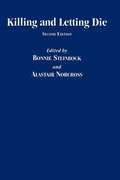
Killing and Letting Die
Par Bonnie Steinbock, Alastair Norcross. 1994
Available in a new digital edition with reflowable text suitable for e-readersThis collection contains twenty-one thought-provoking essays on the controversies…
surrounding the moral and legal distinctions between euthanasia and "letting die." Since public awareness of this issue has increased this second edition includes nine entirely new essays which bring the treatment of the subject up-to-date. The urgency of this issue can be gauged in recent developments such as the legalization of physician-assisted suicide in the Netherlands, "how-to" manuals topping the bestseller charts in the United States, and the many headlines devoted to Dr. Jack Kevorkian, who has assisted dozens of patients to die. The essays address the range of questions involved in this issue pertaining especially to the fields of medical ethics, public policymaking, and social philosophy. The discussions consider the decisions facing medical and public policymakers, how those decisions will affect the elderly and terminally ill, and the medical and legal ramifications for patients in a permanently vegetative state, as well as issues of parent/infant rights. The book is divided into two sections. The first, "Euthanasia and the Termination of Life-Prolonging Treatment" includes an examination of the 1976 Karen Quinlan Supreme Court decision and selections from the 1990 Supreme Court decision in the case of Nancy Cruzan. Featured are articles by law professor George Fletcher and philosophers Michael Tooley, James Rachels, and Bonnie Steinbock, with new articles by Rachels, and Thomas Sullivan. The second section, "Philosophical Considerations," probes more deeply into the theoretical issues raised by the killing/letting die controversy, illustrating exceptionally well the dispute between two rival theories of ethics, consequentialism and deontology. It also includes a corpus of the standard thought on the debate by Jonathan Bennet, Daniel Dinello, Jeffrie Murphy, John Harris, Philipa Foot, Richard Trammell, and N. Ann Davis, and adds articles new to this edition by Bennett, Foot, Warren Quinn, Jeff McMahan, and Judith Lichtenberg.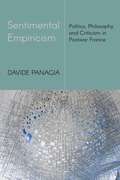
Sentimental Empiricism: Politics, Philosophy, and Criticism in Postwar France
Par Davide Panagia. 2024
Sentimental Empiricism reconsiders the legacy of eighteenth and nineteenth century empiricism and moral sentimentalism for the intellectual formation of the…
generation of postwar French thinkers whose work came to dominate Anglophone conversations across the humanities under the guise of “French theory.” Panagia’s book first shows what was missed in the reception of this literature in the Anglophone academy by attending to how France’s pedagogical milieu plays out church and state relations in the form of educational debates around reading practices, the aesthetics of mimesis, French imperialism, and republican universalism. Panagia then shows how such thinkers as Jean Wahl, Simone de Beauvoir, Gilbert Simondon, Gilles Deleuze, and Michel Foucault develop a sentimental empiricist critical philosophy that distances itself from dialectical critique and challenges the metaphysical premise of inherent relations, especially as it had been articulated in the tradition of Aristotelian scholasticism.Panagia develops the long disputed political legacy of French theory through an exploration of how these thinkers came to understand an aesthetic of mimesis as a credentialing standard for selection to political participation. Since, in France, the ability to imitate well is a state qualification necessary to access offices of elite power, the political, aesthetic, and philosophical critique of mimesis became one of the defining features of sentimental empiricist thought. By exploring the historical, intellectual, cultural, and philosophical complexities of this political aesthetic, Panagia shows how and why postwar French thinkers turned to a tradition of sentimental empiricism in order to develop a new form of criticism attentive to the dispositional powers of domination. This book is available from the publisher on an open access basis.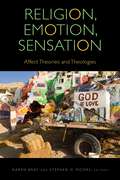
Religion, Emotion, Sensation: Affect Theories and Theologies (Transdisciplinary Theological Colloquia)
Par Karen Bray and Stephen D. Moore. 2020
Religion, Emotion, Sensation asks what affect theory has to say about God or gods, religion or religions, scriptures, theologies, and…
liturgies. Contributors explore the crossings and crisscrossings between affect theory and theology and the study of religion more broadly, as well as the political and social import of such work.Bringing together affect theorists, theologians, biblical scholars, and scholars of religion, this volume enacts creative transdisciplinary interventions in the study of affect and religion through exploring such topics as biblical literature, Christology, animism, Rastafarianism, the women’s Mosque Movement, the unending Korean War, the Sewol ferry disaster, trans and gender queer identities, YA fiction, queer historiography, the prison industrial complex, debt and neoliberalism, and death and poetry.Contributors: Mathew Arthur, Amy Hollywood, Wonhee Anne Joh, Dong Sung Kim, A. Paige Rawson, Erin Runions, Donovan O. Schaefer, Gregory J. Seigworth, Max Thornton, Alexis G. Waller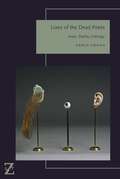
Lives of the Dead Poets: Keats, Shelley, Coleridge (Lit Z)
Par Karen Swann. 2019
Any reader engaging the work of Keats, Shelley, or Coleridge must confront the role biography has played in the canonization…
of each. Each archive is saturated with stories of the life prematurely cut off or, in Coleridge’s case, of promise wasted in indolence. One confronts reminiscences of contemporaries who describe subjects singularly unsuited to this world, as well as still stranger materials—death masks, bits of bone, locks of hair, a heart—initially preserved by circles and then circulating more widely, often in tandem with bits of the literary corpus.Especially when it centers on the early deaths of Keats and Shelley, biographical interest tends to be dismissed as a largely Victorian and sentimental phenomenon that we should by now have put behind us. And yet a line of verse by these poets can still trigger associations with biographical detail in ways that spark pathos or produce intimations of prolepsis or fatality, even for readers suspicious of such effects. Biographical fascination—the untoward and involuntary clinging of attention to the biographical subject—is thus “posthumous” in Keats’s evocative sense of the term, its life equivocally sustained beyond its period.Lives of the Dead Poets takes seriously the biographical fascination that has dogged the prematurely arrested figures of three romantic poets. Arising in tandem with a sense of the threatened end of poetry’s allotted period, biographical fascination personalizes the precariousness of poetry, binding poetry, the poet-function, and readers to an irrecuperable singularity. Reading romantic poets together with the modernity of Benjamin and Baudelaire, Swann shows how poets’ afterlives offer an opening for poetry’s survival, from its first nineteenth-century death sentences into our present.
Here Down on Dark Earth: Loss and Remembrance in New York City
Par Larry Racioppo. 2025
Discover New York’s poignant memorials through powerful photographs capturing everything from fleeting tributes to enduring monumentsThe photographs in Here Down…
on Dark Earth document the many ways New Yorkers express their intertwined feelings of loss and remembrance. The famous and the unknown, the rich and the poor, meet the same fate, but how they are mourned and remembered varies greatly. New York City’s monuments and memorials are large and small, civic and personal, traditional and vernacular, planned and spontaneous. Some commemorate a significant event such as the terrorist attack on the World Trade Center, others the death of a single child hit by a stray bullet. A memorial of stone and steel dedicated to deceased WWII veterans from a church parish may outlast a painted Rest-In-Peace (RIP) memorial wall for a slain teenager. Still, both grow out of the feeling of loss and a desire to preserve the memory of departed loved ones.As Racioppo traveled throughout New York City, he became increasingly aware of the impermanence of these memorials. The paint eventually peels, and the image gradually disappears. Sanitation workers remove the rotted toys and flowers. Small and personal, or large and communal, created by professionals or amateurs, the memorials in Here Down on Dark Earth express a powerful sense of loss and connection. Throughout the book, the author’s contextual notes accompany the poignant photographs depicting these expressions of remembrance.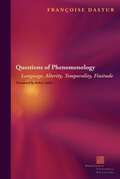
Françoise Dastur is well respected in France and Europe for her mastery of phenomenology as a movement and her clear…
and cogent explications of phenomenology in movement. These qualities are on display in this remarkable volume. Dastur guides the reader through a series of phenomenological questions—language and logic, self and other, temporality and history, finitude and mortality—that also call phenomenology itself into question, testing its limits and pushing it in new directions. Like Merleau-Ponty, Dastur sees phenomenology not as a doctrine, a catalogue of concepts and catchphrases authored by a single thinker, but as a movement in which several thinkers participate, each inflecting the movement in unique ways. In this regard, Dastur is both one of the clearest guides to phenomenology and one of its ablest practitioners.
Sexagon: Muslims, France, and the Sexualization of National Culture
Par Mehammed Amadeus Mack. 2017
Honorable Mention, Association for Middle East Women’s StudiesHonorable Mention, 2018 Arab American Book Awards (Non-Fiction)In contemporary France, particularly in the…
banlieues of Paris, the figure of the young, virile, hypermasculine Muslim looms large. So large, in fact, it often supersedes liberal secular society’s understanding of gender and sexuality altogether. Engaging the nexus of race, gender, nation, and sexuality, Sexagon studies the broad politicization of Franco-Arab identity in the context of French culture and its assumptions about appropriate modes of sexual and gender expression, both gay and straight.Surveying representations of young Muslim men and women in literature, film, popular journalism, television, and erotica as well as in psychoanalysis, ethnography, and gay and lesbian activist rhetoric, Mehammed Amadeus Mack reveals the myriad ways in which communities of immigrant origin are continually and consistently scapegoated as already and always outside the boundary of French citizenship regardless of where the individuals within these communities were born. At the same time, through deft readings of—among other things—fashion photography and online hook-up sites, Mack shows how Franco-Arab youth culture is commodified and fetishized to the point of sexual fantasy.Official French culture, as Mack suggests, has judged the integration of Muslim immigrants from North and West Africa—as well as their French descendants—according to their presumed attitudes about gender and sexuality. More precisely, Mack argues, the frustrations consistently expressed by the French establishment in the face of the alleged Muslim refusal to assimilate is not only symptomatic of anxieties regarding changes to a “familiar” France but also indicative of an unacknowledged preoccupation with what Mack identifies as the “virility cultures” of Franco-Arabs, rendering Muslim youth as both sexualized objects and unruly subjects.The perceived volatility of this banlieue virility serves to animate French characterizations of the “difficult” black, Arab, and Muslim boy—and girl—across a variety of sensational newscasts and entertainment media, which are crucially inflamed by the clandestine nature of the banlieues themselves and non-European expressions of virility. Mirroring the secret and underground qualities of “illegal” immigration, Mack shows, Franco-Arab youth increasingly choose to withdraw from official scrutiny of the French Republic and to thwart its desires for universalism and transparency. For their impenetrability, these sealed-off domains of banlieue virility are deemed all the more threatening to the surveillance of mainstream French society and the state apparatus.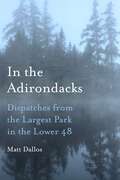
In the Adirondacks: Dispatches from the Largest Park in the Lower 48
Par Matt Dallos. 2023
An immersive journey into the past, present, and future of a region many consider the Northeast’s wilderness backyard. Out of…
all the rural areas of the United States, including those in the West, which are bigger and propped up by more pervasive myths about adventure and nation and wilderness and freedom, the Adirondacks has accumulated a well-known identity beyond its boundaries. Untouched, unspoiled, it is defined by what we haven’t done to it. Combining author Matt Dallos’s personal observations with his thorough research of primary and secondary documents, In the Adirondacks rambles through the region to understand its significance within American culture and what lessons it might offer us for how we think about the environment. In vivid prose, Dallos digs through the region’s past and present to excavate a series of compelling stories and places: a moose named Harold, a hot dog mogul’s rustic mansion, an ecological restoration on an alpine summit, a hermit who demanded a helicopter ride, and a millionaire who dressed up as a Native American to rob a stagecoach. Along the way, Dallos listens to locals and tourists, visits wilderness areas and souvenir shops, and digs through archives in museums and libraries.In the Adirondacks blends lively history and immersive travel writing to explore the Adirondacks that captivated Dallos’s childhood imagination while presenting a compelling and entertaining story about America’s largest park outside of Alaska. The result is an inquisitive journey through the region’s bogs and lakes and boreal forests and the lives of residents and tourists. Dallos turned toward the region to understand why he couldn’t shake it from his mind. What he learned is that he’s not the only one.In the Adirondacks explores the history and future of the most complicated, contested park in North America, raising important questions about the role of environmental preservation and the great outdoors in American history and culture.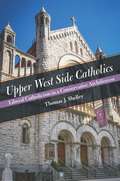
Upper West Side Catholics: Liberal Catholicism in a Conservative Archdiocese
Par Thomas J. Shelley. 2020
This remarkable history of a beloved Upper West Side church is in many respects a microcosm of the history of…
the Catholic Church in New York City.Here is a captivating study of a distinctive Catholic community on the Upper West Side of Manhattan, an area long noted for its liberal Catholic sympathies in contrast to the generally conservative attitude that has pervaded the archdiocese of New York. The author traces this liberal Catholic dimension of Upper West Side Catholics to a long if slender line of progressive priests that stretches back to the Civil War era, casting renewed light on their legacy: liturgical reform, concern for social justice, and a preferential option for the poor long before this phrase found its way into official church documents. In recent years this progressivism has demonstrated itself in a willingness to extend a warm welcome to LGBT Catholics, most notably at the Church of the Ascension on West 107th Street. Ascension was one of the first diocesan parishes in the archdiocese to offer a spiritual home to LGBT Catholics and continues to sponsor the Ascension Gay Fellowship Group.Exploring the dynamic history of the Catholic Church of the Ascension, this engaging and accessible book illustrates the unusual characteristics that have defined Catholicism on the Upper West Side for the better part of the last century and sheds light on similar congregations within the greater metropolis. In many respects, the history of Ascension parish exemplifies the history of Catholicism in New York City over the past two centuries because of the powerful presence of two defining characteristics: immigration and neighborhood change. The Church of the Ascension, in fact, is a showcase of the success of urban ethnic Catholicism. It was founded as a small German parish, developed into a large Irish parish, suffered a precipitous decline during the crime wave that devastated the Upper West Side from the 1960s to the 1980s, and was rescued from near-extinction by the influx of Puerto Rican and Dominican Catholics. It has emerged during the last several decades as a flourishing multi-ethnic, bilingual parish that is now experiencing the restored prosperity and prominence of the Upper West Side as one of Manhattan’s most integrated and popular residential neighborhoods.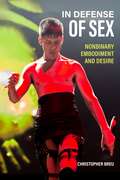
In Defense of Sex: Nonbinary Embodiment and Desire
Par Christopher Breu. 2025
Examines the need to recenter the category of sex–theorizing sex itself as nonbinary–in contemporary studies of gender and sexualityGender has…
largely replaced sex as a category in critical theory, in progressive cultural circles, and in everyday bureaucratic language. Much of this development has been salutary. Gender has become a crucial site for theorizing trans identifications and embodiments. Yet, without a concomitant theory of sex, gender’s contemporary uses also intersect with late neoliberalism’s emphasis on micro-identities, flexibility, avatar culture, and human capital. Contemporary culture has also grown more ambivalent about sexual desire and its expression. Sex is seen as both ubiquitous and ubiquitously a problem.In Defense of Sex theorizes sex as both a nonbinary form of embodiment (one that can complement recent trans conceptions of gender as multiple and nonbinary) and a crucial form of social desire. Drawing on intersex and trans theory as well as Marxist theory, feminist new materialism, psychoanalysis, and accounts of the flesh in Black studies, author Christopher Breu argues for a materialist understanding of embodiment and the workings of desire as they structure contemporary culture. Moving from critique to theorizing embodiment, desire, and forms of bioaccumulation, In Defense of Sex concludes by proposing the unabashedly utopian project of building a sexual and embodied commons.In Defense of Sex: Nonbinary Embodiment and Desire is available from Knowledge Unlatched on an open-access basis.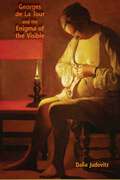
Georges de La Tour and the Enigma of the Visible
Par Dalia Judovitz. 2018
Not rediscovered until the twentieth century, the works of Georges de La Tour retain an aura of mystery. At first…
sight, his paintings suggest a veritable celebration of light and the visible world, but this is deceptive. The familiarity of visual experience blinds the beholder to a deeper understanding of the meanings associated with vision and the visible in the early modern period.By exploring the representations of light, vision, and the visible in La Tour’s works, this interdisciplinary study examines the nature of painting and its artistic, religious, and philosophical implications. In the wake of iconoclastic outbreaks and consequent Catholic call for the revitalization of religious imagery, La Tour paints familiar objects of visible reality that also serve as emblems of an invisible, spiritual reality. Like the books in his paintings, asking to be read, La Tour’s paintings ask not just to be seen as visual depictions but to be deciphered as instruments of insight. In figuring faith as spiritual passion and illumination, La Tour’s paintings test the bounds of the pictorial image, attempting to depict what painting cannot ultimately show: words, hearing, time, movement, changes of heart.La Tour’s emphasis on spiritual insight opens up broader artistic, philosophical, and conceptual reflections on the conditions of possibility of the pictorial medium. By scrutinizing what is seen and how, and by questioning the position of the beholder, his works revitalize critical discussion of the nature of painting and its engagements with the visible world.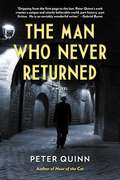
The Man Who Never Returned (The Fintan Dunne Trilogy)
Par Peter Quinn. 2021
Peter Quinn’s The Man Who Never Returned is a noir-ish, stylized detective narrative set in 1950s New York. It follows…
Fintan, a retired detective turned private investigator who has been given the job of finding Judge Crater, who just went missing in 1930. Based on a real story, it is quite an intriguing tale that was even more so for people living at the time. The famous missing-person case is comparable to the Amelia Earhart missing-person case, though it could have been an even more interesting one. It was alleged that the missing judge may have had information about underhanded dealings in the New York judiciary. It was believed that if such information came to light, Franklin D. Roosevelt, then governor of New York, would have had a hard time becoming the president of the United States. There were also rumors that the judge, who was a known ladies’ man, had either decided to disappear or had fallen afoul of the mafia. Featuring hardboiled characters and a beautiful re-creation of New York from the ’50s, it is quite a compelling read.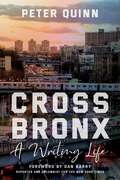
Cross Bronx: A Writing Life
Par Peter Quinn. 2022
In his inimitable prose, master storyteller Peter Quinn chronicles his odyssey from the Irish Catholic precincts of the Bronx to…
the arena of big-league politics and corporate hardball.Cross Bronx is Peter Quinn’s one-of-a-kind account of his adventures as ad man, archivist, teacher, Wall Street messenger, court officer, political speechwriter, corporate scribe, and award-winning novelist. Like Pete Hamill, Quinn is a New Yorker through and through. His evolution from a childhood in a now-vanished Bronx, to his exploits in the halls of Albany and swish corporate offices, to then walking away from it all, is evocative and entertaining and enlightening from first page to last. Cross Bronx is bursting with witty, captivating stories.Quinn is best known for his novels (all recently reissued by Fordham University Press under its New York ReLit imprint), most notably his American Book Award–winning novel Banished Children of Eve. Colum McCann has summed up Quinn’s trilogy of historical detective novels as “generous and agile and profound.” Quinn has now seized the time and inspiration afforded by “the strange interlude of the pandemic” to give his up-close-and-personal accounts of working as a speechwriter in political backrooms and corporate boardrooms:“In a moment of upended expectations and fear-prone uncertainty, the tolling of John Donne’s bells becomes perhaps not as faint as it once seemed. Before judgment is pronounced and sentence carried out, I want my chance to speak from the dock. Let no man write my epitaph. In the end, this is the best I could do.” (from the Prologue)From 1979 to 1985 Quinn worked as chief speechwriter for New York Governors Hugh Carey and Mario Cuomo, helping craft Cuomo’s landmark speech at the 1984 Democratic Convention and his address on religion and politics at Notre Dame University. Quinn then joined Time Inc. as chief speechwriter and retired as corporate editorial director for Time Warner at the end of 2007. As eyewitness and participant, he survived elections, mega-mergers, and urban ruin. In Cross Bronx he provides his insider’s view of high-powered politics and high-stakes corporate intrigue.Incapable of writing a dull sentence, the award-winning author grabs our attention and keeps us enthralled from start to finish. Never have his skills as a storyteller been on better display than in this revealing, gripping memoir.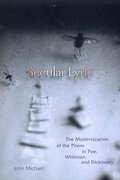
Secular Lyric: The Modernization of the Poem in Poe, Whitman, and Dickinson
Par John Michael. 2018
Secular Lyric interrogates the distinctively individual ways that Poe, Whitman, and Dickinson transformed classical, romantic, and early modern forms of…
lyric expression to address the developing conditions of Western modernity, especially the heterogeneity of believers and beliefs in an increasingly secular society. Analyzing historically and formally how these poets inscribed the pressures of the modern crowd in the text of their poems, John Michael shows how the masses appear in these poets’ work as potential readers to be courted and resisted, often at the same time. Unlike their more conventional contemporaries, Poe, Whitman, and Dickinson resist advising, sermonizing or consoling their audiences. They resist most familiar senses of meaning as well. For them, the processes of signification in print rather than the communication of truths become central to poetry, which in turn becomes a characteristic of modern verse in the Western world. Poe, Whitman, and Dickinson, in idiosyncratic but related ways, each disrupt conventional expectations while foregrounding language’s material density, thereby revealing both the potential and the limitations of art in the modern age.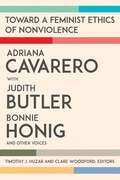
Toward a Feminist Ethics of Nonviolence
Par Judith Butler, Bonnie Honig, Adriana Cavarero. 2021
Toward a Feminist Ethics of Nonviolence brings together major feminist thinkers to debate Cavarero’s call for a postural ethics of…
nonviolence and a sociality rooted in bodily interdependence.Toward a Feminist Ethics of Nonviolence brings together three major feminist thinkers—Adriana Cavarero, Judith Butler, and Bonnie Honig—to debate Cavarero’s call for a postural ethics of nonviolence. The book consists of three longer essays by Cavarero, Butler, and Honig, followed by shorter responses by a range of scholars that widen the dialogue, drawing on post-Marxism, Italian feminism, queer theory, and lesbian and gay politics. Together, the authors contest the boundaries of their common project for a pluralistic, heterogeneous, but urgent feminist ethics of nonviolence.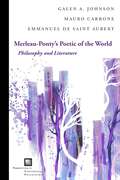
Merleau-Ponty's Poetic of the World: Philosophy and Literature (Perspectives in Continental Philosophy)
Par Galen A. Johnson, Mauro Carbone, Emmanuel de Saint Aubert. 2020
Merleau-Ponty has long been known as one of the most important philosophers of aesthetics, yet most discussions of his aesthetics…
focus on visual art. This book corrects that balance by turning to Merleau-Ponty's extensive engagement with literature.From Proust, Merleau-Ponty developed his conception of “sensible ideas,” from Claudel, his conjoining of birth and knowledge as “co-naissance,” from Valéry came “implex” or the “animal of words” and the “chiasma of two destinies.” Literature also provokes the questions of expression, metaphor, and truth and the meaning of a Merleau-Pontian poetics.The poetic of Merleau-Ponty is, the book argues, a poetic of the flesh, a poetic of mystery, and a poetic of the visible in its relation to the invisible. Ultimately, theoretical figures or “figuratives” that appear at the threshold between philosophy and literature enable the possibility of a new ontology. What is at stake is the very meaning of philosophy itself and its mode of expression.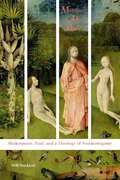
Members of His Body: Shakespeare, Paul, and a Theology of Nonmonogamy
Par Will Stockton. 2017
Building on scholarship regarding both biblical and early modern sexualities, Members of His Body protests the Christian defense of marital…
monogamy. According to the Paul who authors 1 Corinthians, believers would do well to remain single and focus instead on the messiah’s return. According to the Paul who authors Ephesians, plural marriage is the telos of Christian community. Turning to Shakespeare, Will Stockton shows how marriage functions in The Comedy of Errors, The Merchant of Venice, Othello, and The Winter’s Tale as a contested vehicle of Christian embodiment. Juxtaposing the marital theologies of the different Pauls and their later interpreters, Stockton reveals how these plays explore the racial, religious, and gender criteria for marital membership in the body of Christ. These plays further suggest that marital jealousy and paranoia about adultery result in part from a Christian theology of shared embodiment: the communion of believers in Christ.In the wake of recent arguments that expanding marriage rights to gay people will open the door to the cultural acceptance and legalization of plural marriage, Members of His Body reminds us that much Christian theology already looks forward to this end.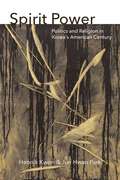
Spirit Power: Politics and Religion in Korea's American Century (Thinking from Elsewhere)
Par Heonik Kwon, Jun Hwan Park. 2022
Spirit Power explores the manifestation of the American Century in Korean history with a focus on religious culture. It looks…
back on the encounter with American missionary power from the late nineteenth century, and the long political struggles against the country’s indigenous popular religious heritage during the colonial and postcolonial eras. The book brings an anthropology of religion into the field of Cold War history. In particular, it investigates how Korea’s shamanism has assimilated symbolic properties of American power into its realm of ritual efficacy in the form of the spirit of General Douglas MacArthur. The book considers this process in dialog with the work of Yim Suk-jay, a prominent Korean anthropologist who saw that a radically cosmopolitan and democratic world vision is embedded in Korea’s enduring shamanism tradition.
A Concise History of Poland: Second Edition
Par Jerzy Lukowski, Hubert Zawadzki. 2001
The second edition of this guide to Poland has been updated to take account of the years from 1989-2005. This…
period marked its liberation from the Soviet Union, the birth of Poland's 'Third Republic' and, recently, its accession to the European Union in 2004. Poland's history has been marked by its resilience. Once a dominant force in central and eastern Europe and home to a remarkable experiment in consensual politics, it was excised from the map by its neighbours in 1795. Resurrected in 1918, partitioned afresh during the Second World War, it survived to become a satellite of the Soviet Union. Yet in the 1980s, it was Poland which blazed the trail in casting off communism, and was finally able to reassert its Christian heritage. With its updated bibliography and new chronology, the book is the ideal companion for all looking for a comprehensive survey of this fascinating country.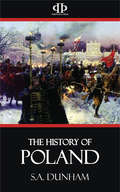
The History of Poland
Par S. A. Dunham. 2015
Amidst the incessant influx of the Asiatic nations into Europe, during the slow decline of the Roman empire, and the…
migrations occasioned by their arrival, we should vainly attempt to trace the descent of the Poles. Whether they are derived from the Sarmatians, who, though likewise of Asiatic origin, were located on both sides of the Vistula long before the irruptions of the kindred barbarians, or from some horde of the latter, or, a still more probable hypothesis, from an amalgamation of the natives and new comers, must for ever remain doubtful. All that we can know with certainty is, that they formed part of the great Slavonic family which stretched from the Baltic to the Adriatic, and from the Elbe to the mouth of the Borysthenes.